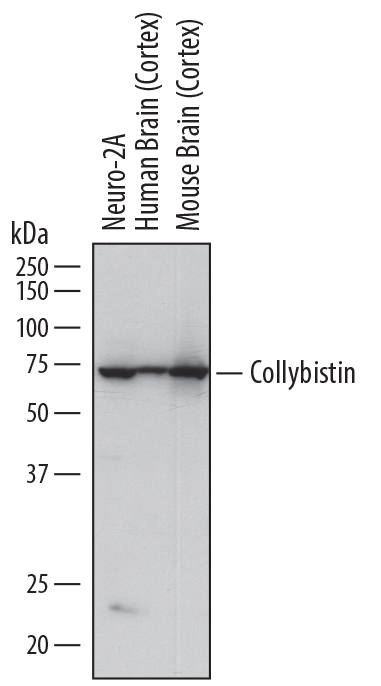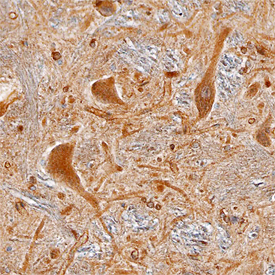Human Collybistin/ARHGEF9 Antibody Summary
Asn390-Lys516
Accession # O43307
Applications
Please Note: Optimal dilutions should be determined by each laboratory for each application. General Protocols are available in the Technical Information section on our website.
Scientific Data
 View Larger
View Larger
Detection of Human and Mouse Collybistin/ARHGEF9 by Western Blot. Western blot shows lysates of Neuro-2A mouse neuroblastoma cell line, human brain (cortex) tissue, and mouse brain (cortex) tissue. PVDF membrane was probed with 2 µg/mL of Mouse Anti-Human Collybistin/ARHGEF9 Monoclonal Antibody (Catalog # MAB7848) followed by HRP-conjugated Anti-Mouse IgG Secondary Antibody (Catalog # HAF007). A specific band was detected for Collybistin/ARHGEF9 at approximately 70 kDa (as indicated). This experiment was conducted under reducing conditions and using Immunoblot Buffer Group 1.
 View Larger
View Larger
Collybistin/ARHGEF9 in Human Brain. Collybistin/ARHGEF9 was detected in immersion fixed paraffin-embedded sections of human brain (medulla) using Mouse Anti-Human Collybistin/ARHGEF9 Monoclonal Antibody (Catalog # MAB7848) at 25 µg/mL overnight at 4 °C. Tissue was stained using the Anti-Mouse HRP-DAB Cell & Tissue Staining Kit (brown; Catalog # CTS002) and counterstained with hematoxylin (blue). Specific staining was localized to neuronal cell bodies and processes. View our protocol for Chromogenic IHC Staining of Paraffin-embedded Tissue Sections.
Reconstitution Calculator
Preparation and Storage
- 12 months from date of receipt, -20 to -70 °C as supplied.
- 1 month, 2 to 8 °C under sterile conditions after reconstitution.
- 6 months, -20 to -70 °C under sterile conditions after reconstitution.
Background: Collybistin/ARHGEF9
Collybistin, also known as ARHGEF9, is an approximately 60 kDa cytoplasmic guanine nucleotide exchange factor. It is expressed in the brain and is upregulated at the onset of neuronal differentiation. Collybistin associates with Neuroligin-2, Gephyrin, and GABA receptor subunits to form a complex which is required for GABAergic synaptogenesis as well as hippocampal synaptic plasticity. Mutations in Collybistin are associated with a variety of neurological disorders including epilepsy, anxiety, aggression, mental retardation, and hyperplexia. Human Collybistin contains an SH3 domain (aa 8-67), a DH domain (aa 103-287), and a Pleckstrin homology domain (aa 318-426). Within aa 390-516, human Collybistin shares 97% and 57% aa sequence identity with mouse and rat Collybistin, respectively.
Product Datasheets
Citation for Human Collybistin/ARHGEF9 Antibody
R&D Systems personnel manually curate a database that contains references using R&D Systems products. The data collected includes not only links to publications in PubMed, but also provides information about sample types, species, and experimental conditions.
1 Citation: Showing 1 - 1
-
Presynaptic neuronal pentraxin receptor organizes excitatory and inhibitory synapses
Authors: Sung-Jin Lee
J. Neurosci, 2016-12-16;0(0):.
Species: Human
Sample Types: Whole Cells
Applications: ICC
FAQs
No product specific FAQs exist for this product, however you may
View all Antibody FAQsReviews for Human Collybistin/ARHGEF9 Antibody
There are currently no reviews for this product. Be the first to review Human Collybistin/ARHGEF9 Antibody and earn rewards!
Have you used Human Collybistin/ARHGEF9 Antibody?
Submit a review and receive an Amazon gift card.
$25/€18/£15/$25CAN/¥75 Yuan/¥2500 Yen for a review with an image
$10/€7/£6/$10 CAD/¥70 Yuan/¥1110 Yen for a review without an image

